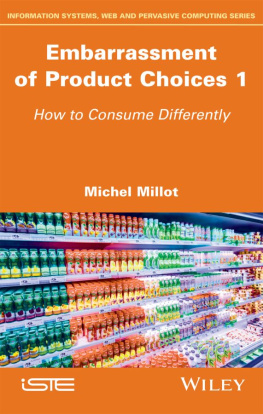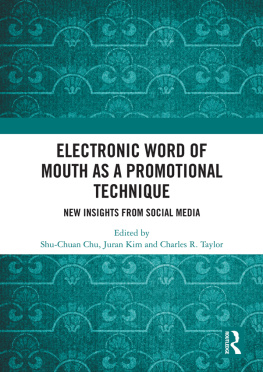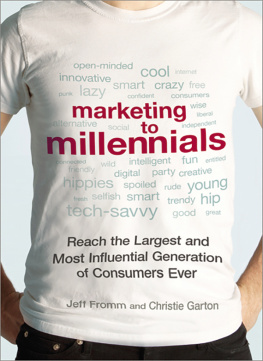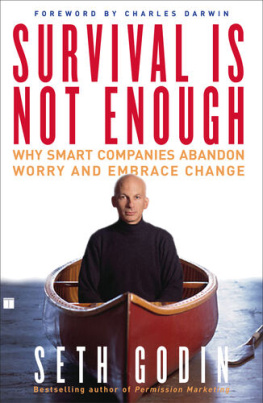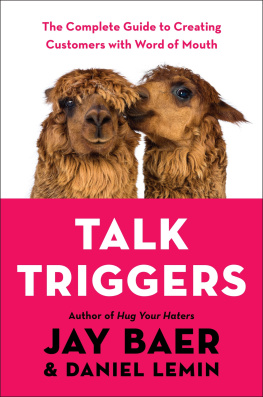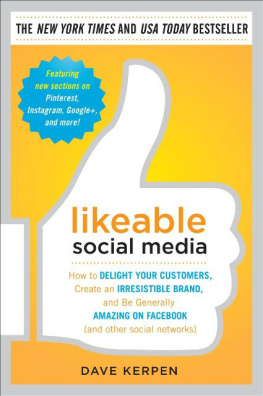
Embarrassment of Product Choices 1
How to Consume Differently
Michel Millot
First published 2018 in Great Britain and the United States by ISTE Ltd and John Wiley & Sons, Inc.
Apart from any fair dealing for the purposes of research or private study, or criticism or review, as permitted under the Copyright, Designs and Patents Act 1988, this publication may only be reproduced, stored or transmitted, in any form or by any means, with the prior permission in writing of the publishers, or in the case of reprographic reproduction in accordance with the terms and licenses issued by the CLA. Enquiries concerning reproduction outside these terms should be sent to the publishers at the undermentioned address:
ISTE Ltd
27-37 St Georges Road
London SW19 4EU
UK
www.iste.co.uk
John Wiley & Sons, Inc.
111 River Street
Hoboken, NJ 07030
USA
www.wiley.com
ISTE Ltd 2018
The rights of Michel Millot to be identified as the author of this work have been asserted by him in accordance with the Copyright, Designs and Patents Act 1988.
Library of Congress Control Number: 2018951366
British Library Cataloguing-in-Publication Data
A CIP record for this book is available from the British Library
ISBN 978-1-78630-311-0
Preface
Making a Choice Means Solving a Problem
Unable to escape from a seemingly never-ending barrage of commercial marketing, advertising, disinformation and even scams, consumers and purchasers fall victim to the economic necessity of companies. How is it possible to consciously take into account factors including usage, convenience and the environment, together with the benefits of marketing and technology, to ultimately provide a better quality of life?
In reality, the consumer/purchaser is nothing more than a consumer of illusions: the many different powers of hype, publicity and disinformation mean that they are sold little more than fantasies. When choosing a product, the consumer finds themself obligated to navigate through a barrage of unnecessary but deliberate over information or misinformation; not just too much information, but information that is useless, even misleading. Over information is a source of disruption because of its impact on the ability of consumers to process information in a relevant way. It is also a means of manipulation, because the mental confusion it generates leaves scarce room for reasoning.
In any case, the available information on products and services is still far too commercial (e.g. prospectuses, advertising materials, websites, sellers, etc.) or technical (i.e. descriptions, specialized press materials, laboratory measurements).
There is a global mismatch between the reality of the quality of products and the perception that customers have of them. The information that reaches consumers is almost always nebulous, widely varying in nature, and incomplete. Even the best choice or the best quality/price relationship given by consumer organizations is often too simplistic or illusory, and the ostensibly unbiased information clearly comes with the risk of making inappropriate choices for varying use cases. For their part, the consumer or purchaser, without an appropriate level of basic education on marketing tactics and the psychological effects of advertising, is inclined to make the least amount of effort: exactly what marketing departments hope for, and what their campaigns are geared toward. The consumer/purchaser does not have the intellectual and material resources to determine the true quality, uses and characteristics of products, let alone the specifics of what an optimal purchasing decision requires.
A heartfelt thank you to my friends who have made corrections: Yves Duffal, Nicole Forterre, Franois Jacquet, Jean-Claude Jacquet, Michel Jacquet and Jean-Claude Ludi.
Michel MILLOT
July 2018
Introduction
The Hegemony of Market Value
I.1. Market value versus usage value: customers, consumers and users
The many different complex relationships between products, users and backgrounds have yet to be considered as valid and serious issues. Market values have dominated usage values, for a multitude of reasons. It may be some time before marketing professionals figure out that it is a bad idea to confuse their own consumers (i.e. the customers) and their users, a mistake that can have serious consequences. The market economy, which claims to serve consumers, has instead enslaved them, reducing them to mere economic accessories. This is a system that works as long as it remains profitable. Ultimately however, this is of little importance, as often, the people making the purchases are not necessarily the ones who will use the product, nor the ones who will have to deal with its irritations!
Sales figures have no direct connection with the quality of a product. It is therefore logical that all efforts have been made on the market value, with its usage value reduced to the idea of the essential function of the product, to the motive of the purchase (it has this function, it assists with this task, it is used to do that, etc.). As we will see, this system only works because consumers are not clear about their choices.
Information about products or services is organized according to profits, and not according to the cases and/or requirements for use. The system encourages us to consume, to equip ourselves with lots of stuff, and in fact to not use these products very often otherwise, in the absence of an education about the market, users would have more power as customers and buyers. Thus, the number of intermediaries who intervene throughout the purchasing chain has steadily increased with the increasing complexity of economic and social structures. These intermediaries function as the interpreters of future users, predicting their needs and desires. The result is an inevitable dilution of responsibility with regard to the interpretation of users requirements. The criteria of use determined at the purchasing stage are thus only taken into account after the product is purchased and used, and prove to be warped and distorted. Whatever we proclaim, the awareness of the factors relating to usage and the environment is a concern that has been almost completely set aside. Our choices in the consumption of objects and soliciting of services are thoroughly placed under the control of and remain firmly in the grip of technology and marketing.
I.2. A suckers market
Nobody ever sets out to be scammed. Yet this is exactly what happens to us every day: we fall for unnecessary or dangerous medicines, falsely innovative products, services with hidden charges, etc. Far from being accidental, lies and manipulation are an integral part of commerce. Why is this? Because the balance of the market is not necessarily perfect. The competition is such that any opportunity for profit is systematically exploited, resulting all too often in a suckers market, filled with nave customers who have deceived. But also, accepting the mechanism of how we receive information leads us to make bad economic decisions.
For marketing strategists, the needs of the consumer remain sacred, at least in terms of principles. The motivations and desires that arise make it possible to sell and produce more. Does this really generate the greatest benefit for everyone? As the saying goes, A product that sells well is a good product. Marketing-specific methods are used to determine and interpret the needs of the consumer but their main focus is always their own, not the consumers: the struggle to compete.
Next page
